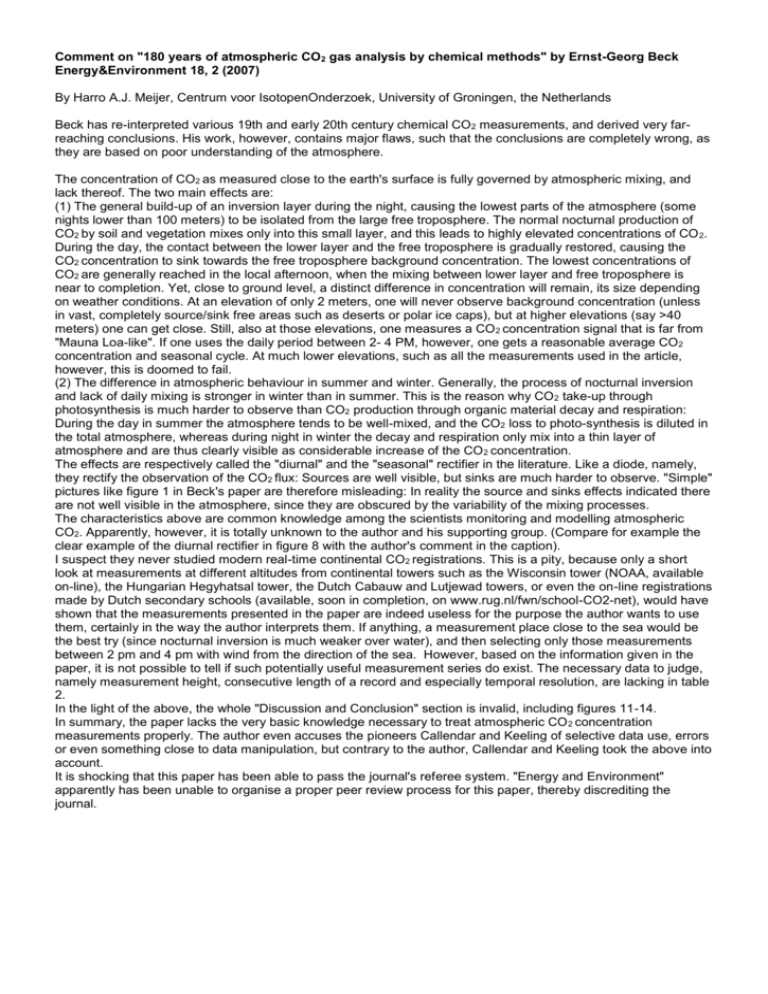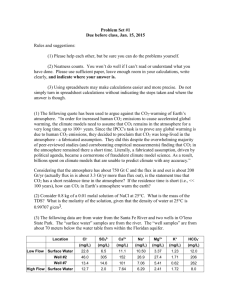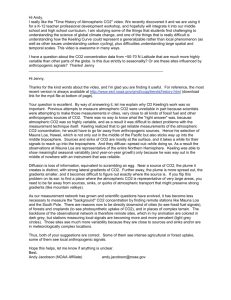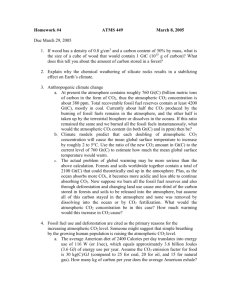Comment on " 180 Years of atmospheric CO2 gas analysis by
advertisement

Comment on "180 years of atmospheric CO2 gas analysis by chemical methods" by Ernst-Georg Beck Energy&Environment 18, 2 (2007) By Harro A.J. Meijer, Centrum voor IsotopenOnderzoek, University of Groningen, the Netherlands Beck has re-interpreted various 19th and early 20th century chemical CO2 measurements, and derived very farreaching conclusions. His work, however, contains major flaws, such that the conclusions are completely wrong, as they are based on poor understanding of the atmosphere. The concentration of CO2 as measured close to the earth's surface is fully governed by atmospheric mixing, and lack thereof. The two main effects are: (1) The general build-up of an inversion layer during the night, causing the lowest parts of the atmosphere (some nights lower than 100 meters) to be isolated from the large free troposphere. The normal nocturnal production of CO2 by soil and vegetation mixes only into this small layer, and this leads to highly elevated concentrations of CO 2. During the day, the contact between the lower layer and the free troposphere is gradually restored, causing the CO2 concentration to sink towards the free troposphere background concentration. The lowest concentrations of CO2 are generally reached in the local afternoon, when the mixing between lower layer and free troposphere is near to completion. Yet, close to ground level, a distinct difference in concentration will remain, its size depending on weather conditions. At an elevation of only 2 meters, one will never observe background concentration (unless in vast, completely source/sink free areas such as deserts or polar ice caps), but at higher elevations (say >40 meters) one can get close. Still, also at those elevations, one measures a CO 2 concentration signal that is far from "Mauna Loa-like". If one uses the daily period between 2- 4 PM, however, one gets a reasonable average CO 2 concentration and seasonal cycle. At much lower elevations, such as all the measurements used in the article, however, this is doomed to fail. (2) The difference in atmospheric behaviour in summer and winter. Generally, the process of nocturnal inversion and lack of daily mixing is stronger in winter than in summer. This is the reason why CO 2 take-up through photosynthesis is much harder to observe than CO2 production through organic material decay and respiration: During the day in summer the atmosphere tends to be well-mixed, and the CO2 loss to photo-synthesis is diluted in the total atmosphere, whereas during night in winter the decay and respiration only mix into a thin layer of atmosphere and are thus clearly visible as considerable increase of the CO 2 concentration. The effects are respectively called the "diurnal" and the "seasonal" rectifier in the literature. Like a diode, namely, they rectify the observation of the CO2 flux: Sources are well visible, but sinks are much harder to observe. "Simple" pictures like figure 1 in Beck's paper are therefore misleading: In reality the source and sinks effects indicated there are not well visible in the atmosphere, since they are obscured by the variability of the mixing processes. The characteristics above are common knowledge among the scientists monitoring and modelling atmospheric CO2. Apparently, however, it is totally unknown to the author and his supporting group. (Compare for example the clear example of the diurnal rectifier in figure 8 with the author's comment in the caption). I suspect they never studied modern real-time continental CO2 registrations. This is a pity, because only a short look at measurements at different altitudes from continental towers such as the Wisconsin tower (NOAA, available on-line), the Hungarian Hegyhatsal tower, the Dutch Cabauw and Lutjewad towers, or even the on-line registrations made by Dutch secondary schools (available, soon in completion, on www.rug.nl/fwn/school-CO2-net), would have shown that the measurements presented in the paper are indeed useless for the purpose the author wants to use them, certainly in the way the author interprets them. If anything, a measurement place close to the sea would be the best try (since nocturnal inversion is much weaker over water), and then selecting only those measurements between 2 pm and 4 pm with wind from the direction of the sea. However, based on the information given in the paper, it is not possible to tell if such potentially useful measurement series do exist. The necessary data to judge, namely measurement height, consecutive length of a record and especially temporal resolution, are lacking in table 2. In the light of the above, the whole "Discussion and Conclusion" section is invalid, including figures 11-14. In summary, the paper lacks the very basic knowledge necessary to treat atmospheric CO 2 concentration measurements properly. The author even accuses the pioneers Callendar and Keeling of selective data use, errors or even something close to data manipulation, but contrary to the author, Callendar and Keeling took the above into account. It is shocking that this paper has been able to pass the journal's referee system. "Energy and Environment" apparently has been unable to organise a proper peer review process for this paper, thereby discrediting the journal.











